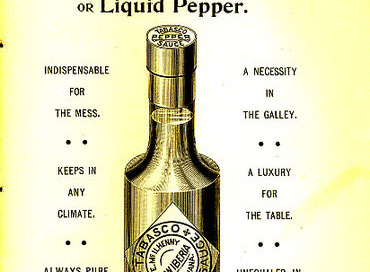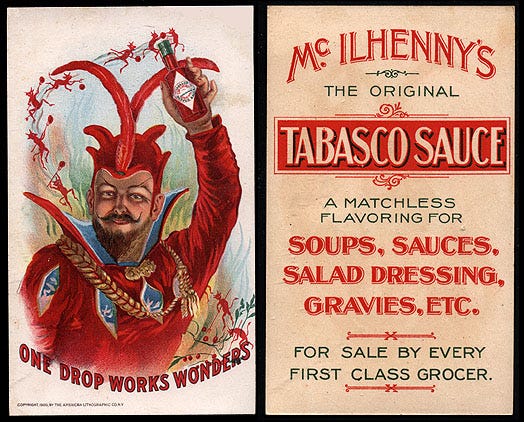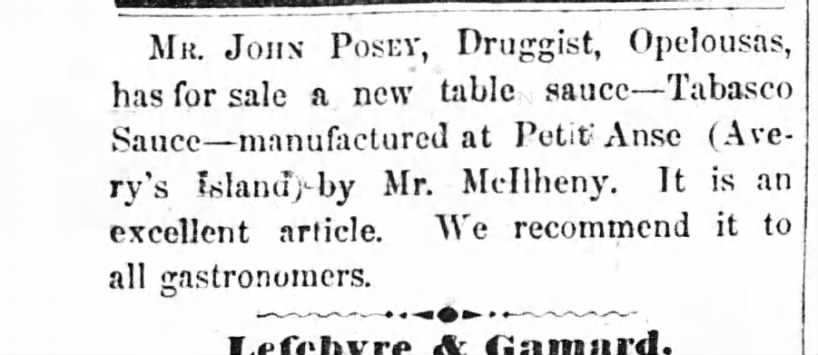Happy January, and cheers to another year of Missing Pieces! I’m delighted to start off the new year with a piece coauthored with my sister, Rebekah Slonim, author of Strike-Through, an editing newsletter.
In honor of National Hot Sauce Day celebrated every year on January 22, we’re looking at the hot sauce brand that inspired this holiday—Tabasco sauce—which was first bottled 156 years ago on January 22, 1868.
Source: Wikimedia Commons. Advertisement in September 1900 Proceedings magazine.
Rachel will start with some historical background on brand names in the Gilded Age and Progressive Era (GAPE) before turning it over to Rebekah, who will briefly discuss style guide rules about brand names. We’ll both focus on Tabasco sauce in particular.
Then—depending on which newsletter to which you subscribe—you’ll get a special section about either Theodore Roosevelt’s connection to the family behind Tabasco sauce for Missing Pieces or a more thorough discussion of brand names and trademarks (plus some dos and don’ts) for Strike-Through.
If you don’t already subscribe to both of our newsletters but would like to, check out Missing Pieces (written by Rachel Lane) here and Strike-Through (written by Rebekah Slonim) here.
Not Just for Cattle
Brand names are a relatively new phenomenon. Prior to the American Civil War, the word “brand” was originally used in the context of livestock and agriculture. It wasn’t until the late 1800s and early 1900s that the word “brand” began to be used to refer to manufacturing and commerce.
As Gustav A. Berghoff, president of Rub-No-More Co., noted at the turn of the century, commerce changed dramatically: “The method of twenty-five years ago is reversed today.” Previously a consumer just sought a particular item, and a retailer sold “from his stock on hand” without consideration of the particular manufacturer.
But by the early 1900s, a consumer desired more than a particular item; she wanted a particular brand. According to Berghoff, “At tremendous expense the manufacturer educates her to ask for Fels Naphtha, Ivory, Rub-No-More, etc., as the case may be.”
The Hot Sauce That Started It All
Of course, many brands and companies well-known in the GAPE (like Rub-No-More!) have disappeared from existence today. But some like Tabasco sauce have stood the test of time.
Although there is some dispute, the traditional story of the creation of Tabasco sauce suggests that Edmund McIlhenny saved his family from financial ruin after the American Civil War by inventing Tabasco sauce. After the war, he moved his family to Avery Island, Louisiana, where his wife’s family lived.
In the late 1860s, McIlhenny acquired tabasco pepper seeds, planted them in his garden, and then began trying to make a sauce, mixing crushed peppers with salt from the island and vinegar, which he aged for two months. McIlhenny received a patent for his creation in 1870.
It appears that John Posey, a druggist in Opelousas, Louisiana, was one of the first people to sell Tabasco sauce, according to an advertisement in an Opelousas newspaper in late 1869. That was just the beginning. The product soon gained traction and began to appear in stores across the region.
Source: St. Landry Democrat, Opelousas, Louisiana, December 25, 1869
Soon it garnered national attention. States across the country began to advertise Tabasco sauce in their local papers. As one example, the Wilmington Journal of Wilmington, North Carolina, advertised “McIlhenny’s New Iberia Tabasco Pepper Sauce” at Charles D. Myers & Co. on North Front Street in the October 24, 1873, paper.
Source: Wilmington Journal, Wilmington, North Carolina, October 24, 1873
McIlhenny’s success soon prompted other people to try their hand at making hot sauce using Tabasco peppers, including a former employee, B. F. Trappey, who founded B. F. Trappey and Sons in 1898 and began selling its own Tabasco sauce using seeds from Avery Island.
In 1906, McIlhenny’s company received registration for exclusive usage of the Tabasco trademark. In the ensuing years, the company fought several legal battles regarding the exclusivity of the Tabasco trademark.
On July 29, 1918, the Fifth US Circuit Court of Appeals recognized McIlhenny’s company as the only one with exclusive right to use the trademark “Tabasco.” The trademark was formally registered in the United States in 1927.
Yes, It’s “RedHot” Sauce
Today I (Rebekah) am going to provide some guidance on properly referencing brand names in writing.
The Chicago Manual of Style encourages using generic terms rather than brand names, when applicable. Say “tissues” instead of “Kleenex” unless you’re making a Kleenex-specific reference: “She prefers Kleenex to Puffs.” Say “Pass the hot sauce” instead “Pass the Tabasco sauce”—unless both Tabasco sauce and Frank’s RedHot sauce are on the table.
Notice that I wrote “RedHot.” That’s how the company capitalizes, spells, and formats the name of their hot sauce. While, according to CMOS, we don’t need to litter our references to brand names with trademark symbols, we do follow the spelling and punctuation that the company prefers—within reason.
The Tabasco website styles the name of the “hot sauce that started it all” as “TABASCO® Original Red Pepper Sauce.” According to The AP Stylebook, “Do not use all-capital-letter names unless the letters are individually pronounced: BMW. Others should be uppercase and lowercase. Ikea, not IKEA.” Using all caps is the equivalent of shouting in print—it shouldn’t be done unless it’s necessary.
And I don’t think the capitals are really necessary for “Original Red Pepper Sauce.” I would call it “Tabasco original red pepper sauce,” and I would only say that if I were distinguishing between different types of Tabasco sauce, such as “My favorite types of Tabasco sauce are Tabasco original red pepper sauce, Tabasco habanero pepper sauce, and Tabasco chipotle pepper sauce.” Otherwise, I think the more generic “Tabasco sauce” is a clear enough reference to the original red pepper sauce, because that’s what most people are referring to when they say “Tabasco sauce.”
For the rest of Rebekah’s editing guidance, click here. Back to Rachel.
Theodore Roosevelt and Avery Island
Edmund McIlhenny, the founder of Tabasco sauce, married Mary Eliza Avery and had eight children with her. After his death in 1890, two of his sons, John Avery McIlhenny and Edward “Ned” Avery McIlhenny, oversaw the company.
John Avery McIlhenny resigned from the company in 1898 to serve with Theodore Roosevelt’s voluntary calvary regiment known as the Rough Riders. He served in the Battle of Las Guásimas and the Battle of San Juan Hill during the Spanish-American War and earned the praise of Roosevelt in TR’s 1899 book, The Rough Riders.
“We could have filled up the whole regiment many times over from the South Atlantic and Gulf States alone, but were only able to accept a very few applicants. One of them was John McIlhenny, of Louisiana; a planter and manufacturer, a big-game hunter and book-lover, who could have had a commission in the Louisiana troops, but who preferred to go as a trooper in the Rough Riders because he believed we would surely see fighting.” ~TR on John Avery McIlhenny
McIlhenny may have even saved TR’s life during the Spanish-American War. According to McIlhenny’s son Jack, his father saw a Spanish sniper take aim at TR and pulled TR down. The bullet went through TR’s hat, but his life had been spared. According to Jack, TR was appreciative but asked McIlhenny not to mention it to anyone.
After the war, TR, McIlhenny, and their families kept in touch via letters with occasional visits to see one another. TR even appointed McIlhenny to serve as Civil Service Commissioner, a position he held from 1906 to 1919.
Several notable visits included two hunting trips—one in 1902 when TR refused to shoot the tied-up bear, sparking the creation of the teddy bear, and one in 1907 in which TR successfully shot a bear on his thirteenth day hunting. Another prominent visit was TR’s flamboyant elder daughter Alice Roosevelt’s stay with the McIlhennys in 1903 before traveling to New Orleans for Mardi Gras.
Although I haven’t been able to find any record of TR trying the famous McIlhenny Tabasco sauce, I think there’s a good chance he did at least once during all of his interactions with the McIlhennys.
Even if TR never tried McIlhenny’s famous Tabasco sauce, it’s still worth celebrating National Hot Sauce Day with some of your favorite red stuff. But if hot sauce isn’t your thing, you can always just watch Business Insider’s short YouTube video on how it’s made.
Americans love hot sauce. According to a recent Instacart survey, almost three-quarters of Americans eat hot sauce with their food. Sriracha is the preferred hot sauce in thirty-one states followed by Frank’s RedHot in fourteen states. And you might be surprised by the state that orders the most hot sauce—North Dakota! Cast your vote for your favorite hot sauce below.










![[President Teddy Roosevelt posing with his Spanish-American War Rough Rider friend Lieutenant John McIlhenny from Avery Island, Louisiana, 1907, aboard the Steamboat Mississippi] [President Teddy Roosevelt posing with his Spanish-American War Rough Rider friend Lieutenant John McIlhenny from Avery Island, Louisiana, 1907, aboard the Steamboat Mississippi]](https://substackcdn.com/image/fetch/$s_!IHYm!,w_1456,c_limit,f_auto,q_auto:good,fl_progressive:steep/https%3A%2F%2Fsubstack-post-media.s3.amazonaws.com%2Fpublic%2Fimages%2Feecd5819-1252-49d1-9d97-986c9fda88d9_640x408.jpeg)
I'm surprised that some of these hot sauces have been around for so long! I do remember my great-grandmother always using Texas Pete.